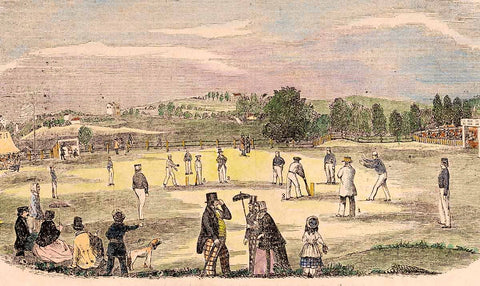A Brief History of Cricket
Cricket is a global passion, played everywhere from Test match arenas to village greens, tropical beaches and dusty back lots.

Early days
Cricket was first recorded in 16th-century England, and it was played in grammar schools, farm communities and everywhere in between. But things really took off when 18th-century nobles realized that not only was it a great sport but also an excellent opportunity for betting.
With sky-high stakes being wagered, it was deemed necessary to come up with agreed rules.
The oldest surviving set of cricket laws date from 1744 – printed on a handkerchief, naturally. It's now in the MCC Museum at Lord’s in London.
The oldest permanent fixture is the annual Eton v Harrow match, played since 1805. A young Lord Byron turned out for Harrow in the first match, though history doesn't record how poetic – or “mad, bad and dangerous” – his bowling was.
The first international match was in 1877 when Australia beat England in Melbourne. The match was dubbed a “Test”, since the grueling nature of playing over five days was deemed the ultimate “test” for any side.
But it was Australia’s first win on English soil – in 1882 at The Oval in London – that led to matches between the two nations being christened the Ashes. Following the defeat, newspapers published an obituary mourning “the death of English cricket”, adding that “the body will be cremated and the ashes taken to Australia”.
Great players
Cricket’s earliest star was WG Grace, who played 44 seasons from 1865 to 1908. Despite the game’s reputation as the epitome of fairness, Grace was as famous for his gamesmanship as his batting. He once ran three, then when the ball was flung in from the outfield, caught it, put it in his pocket and ran three more.
The top batsman in history is India’s Sachin Tendulkar, who retired in 2013 after scoring 15,921 runs in 200 Tests and 18,426 in 463 one-day internationals. He is the only player to have made 100 international centuries, was the first batsman to score a double century in a one-day International and is the only player to amass more than 30,000 international runs.
A special mention must go to West Indies' legend Sir Garfield (Gary) Sobers, who became the first batsman to hit six sixes in a single over off six consecutive balls in first-class cricket, playing for Nottinghamshire against Glamorgan in 1968.
Legendary matches
Perhaps the most famous match in English history was the third Test against Australia at Headingley in 1981. England were made to follow on and, with wickets falling fast in their second innings, were given odds of 500-1 to win the match.
But a gung-ho second-innings 149 from Ian Botham, followed by eight wickets for 43 runs from Bob Willis, turned the match on its head and earned england an 18-run victory. It was the first time in 104 years of Test history that a side had won a match after following on.
Super stats
The fastest ball bowled was 161.3 km/h (100.23mph) by Shoaib Akhtar for Pakistan against England in a 2003 World Cup match in South Africa.
The longest Test innings by a batsman was 970 minutes – more than 16 hours – by Hanif Mohammad, when scoring 337 for Pakistan against the West Indies in 1958. Mohammad claimed he actually batted for 999 minutes.
The highest individual Test score is West Indies batsman Brian Lara’s 400 not out against England in Antigua in 2004. Lara also made the highest first-class score of 501 not out for Warwickshire against Durham at Edgbaston in 1994. The highest first class total is 1,107 hit by Victoria against New South Wales in 1926. By contrast, the lowest total is the miserable 12 scored by Northants playing Gloucester in 1907.
